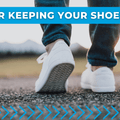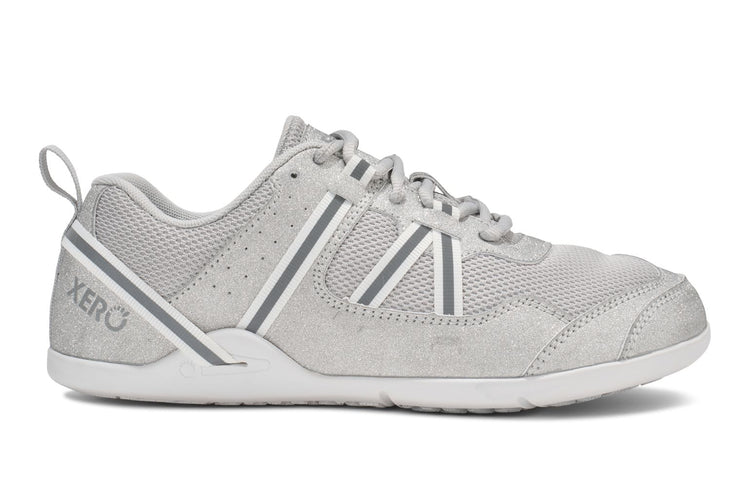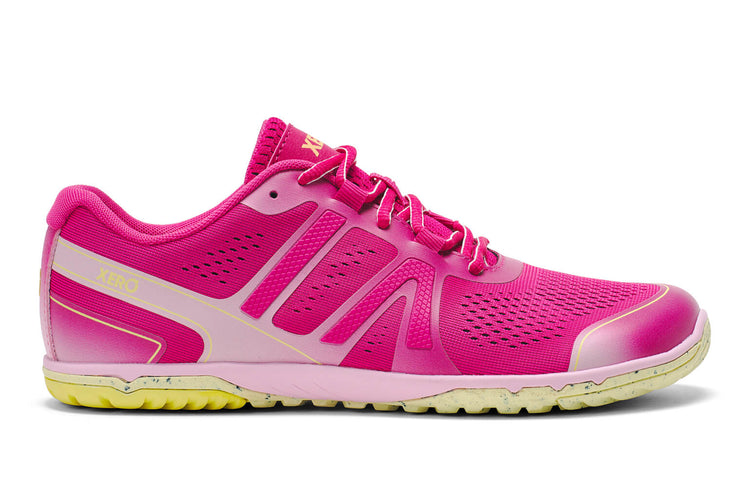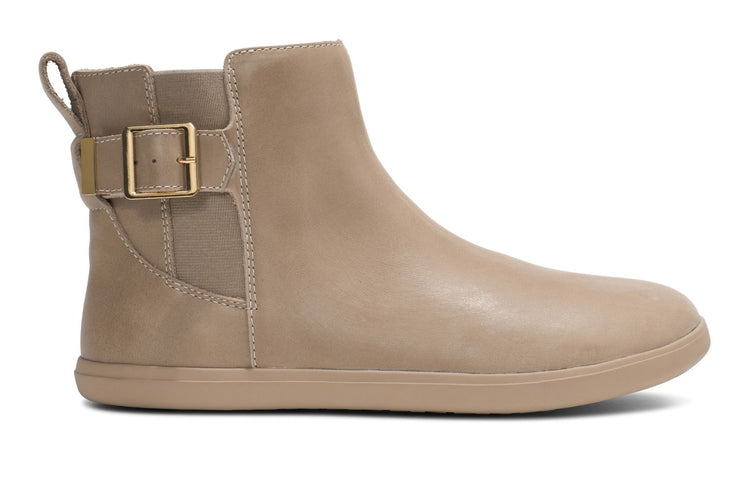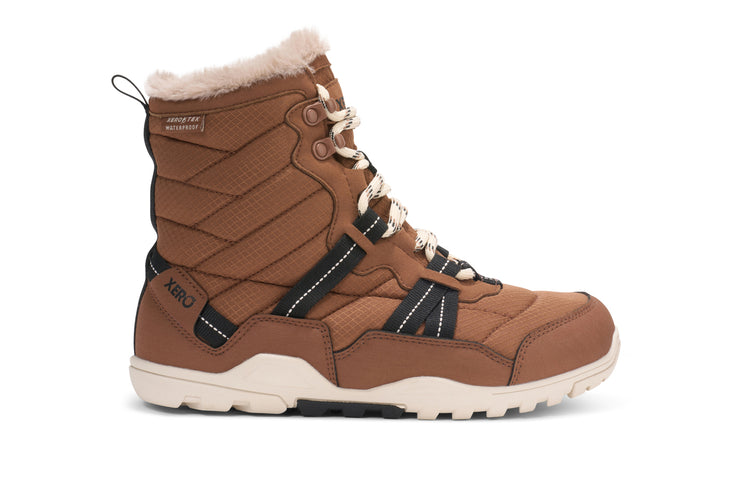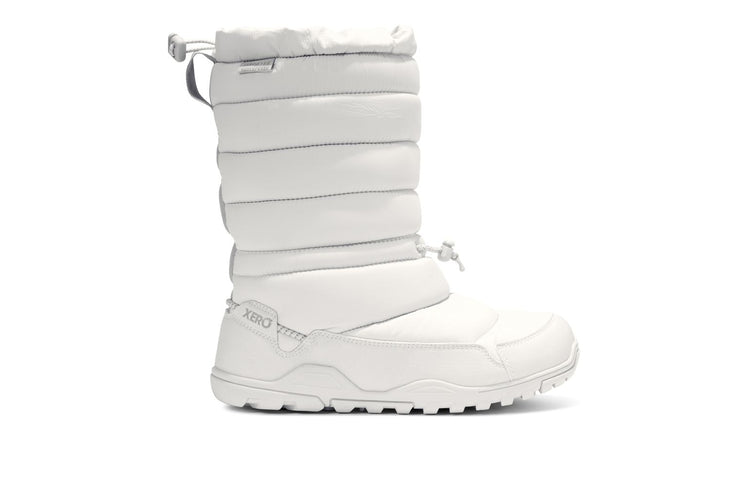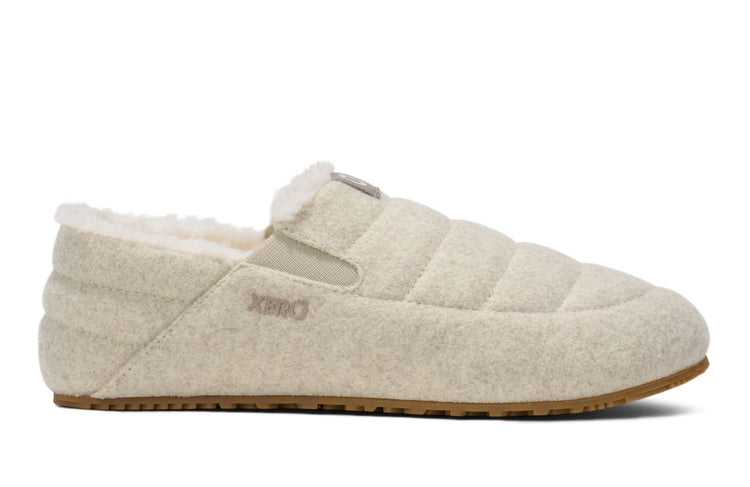“The Dream Shoe”: A Partnership with Xero Shoes & Born to Run 2 Authors
latest News
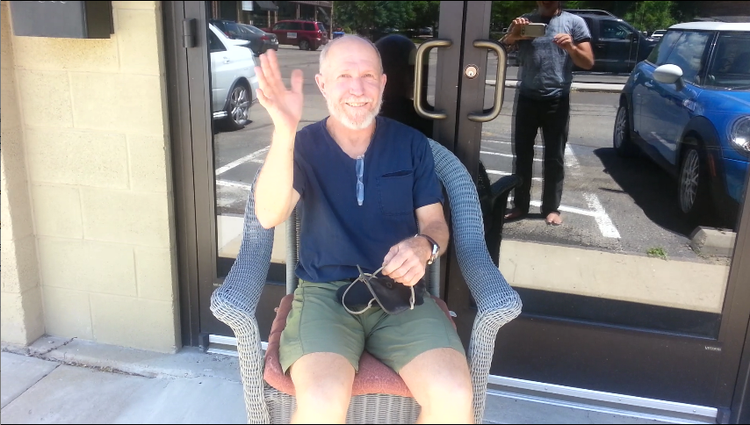
Barefoot Sandals, Triathalons, and Speed
I got a call today from someone asking: I'm a triathlete, and I love the idea of barefoot running, or using your sandals... but how quickly can I put these on and then run with them? The time to transition between biking and running is important to me. And once they're on, will they fall off? Good questions. There are a number of "slip-on/slip-off" tying styles you can use with Xero Shoes (as well as tying styles that you have to lace up every time you wear them). When you have the tension correct, there's no problem sliding them onto your foot and having them stay securely for a run, walk, hike, yoga class, or whatever you're doing. And it takes just a second to put 'em on. I hold the knot at the top of the sandal in one hand, hold the heel strap in the other, slide my foot all the way in, and then flip the heel strap over my heel. Simple. To prove it, here's a quick video of our former Customer Service Manager, Bill Babcock, slipping on his Xero Shoes. Bill is also an ultramarathoner who knocks off 100+ miles/week wearing his Xero Shoes with an ultra-minimalist tying, slip-on/slip-off tying style. In fact, in this video, Bill is wearing shoes with the MOST minimalist tying style ever created, which you can find here
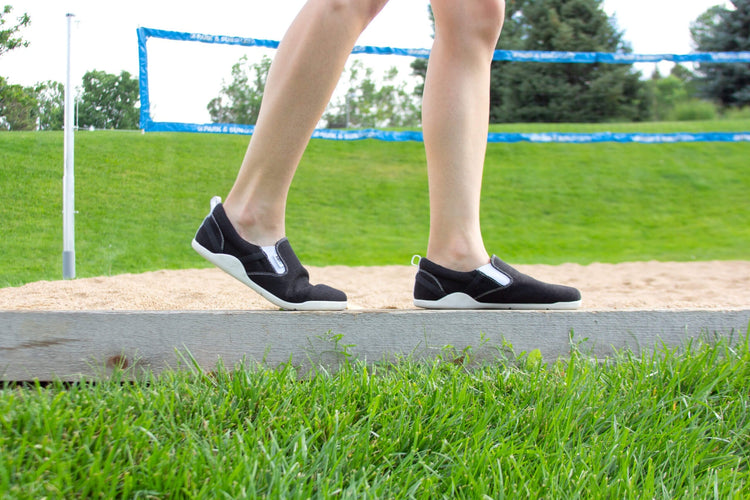
Are Barefoot Shoes Good for Plantar Fasciitis?
It is estimated that around 10% of the population suffers from heel pain caused by plantar fasciitis. Interestingly, though the condition is quite common, we don’t know as much as you might expect about what causes it and how to treat it. I often hear from runners who have switched to barefoot-style running that they have experienced freedom from the plantar fasciitis that used to bother them. In this article, I’d like to share a bit about some research that points to a reason why this may be happening. If you suffer from plantar fasciitis, you may find this opens up some new directions to explore as you seek optimal foot health. I’ll start off with some important background about what plantar fasciitis is, what seems to cause it, and how it’s often misdiagnosed. Then we’ll look at some research that points to an interesting new approach to helping people find relief. What is plantar fasciitis? On the bottom of your foot, there is a thick band of tissue, called the plantar fascia, that connects the front of the foot with the heel bone. The plantar fascia helps to support the arch of the foot and absorbs shock when our feet hit the ground. The plantar fascia can become inflamed and cause stabbing pain in the heel. Typically, symptoms are at their worst upon waking in the morning and improve once you get up and move around. What causes plantar fasciitis? Many people believe that plantar fasciitis is caused by repetitive stress. Stresses to the plantar fascia can cause small tears and these, in turn, can lead to inflammation and heel pain. What causes this kind of stress? In the literature, certain risk factors are associated with a greater likelihood that a person will experience plantar fasciitis, like doing lots of running, having a higher weight, or being in an occupation that keeps you on your feet all day. This seems to make sense. If plantar fasciitis results from repetitive stresses to your plantar fascia, those factors sound like ways of ramping up the demands placed upon your feet. But what if it’s not repetitive activities, or weight, that’s the real cause of the problem? For example, what if running form is the issue? Some ways of running place a lot more stress on your feet than others. So, the standard description of the cause of plantar fasciitis encourages us to think in terms of a simplistic picture: that repetitive stress is the input and plantar fasciitis is the output. And yet you’re about to discover that there is an important mediating factor that has a lot to do with the stresses we’ll actually experience, whatever our activity level, and how those will impact our feet. Is it really plantar fasciitis? But first, plantar fasciitis can be easily misdiagnosed. Sometimes the symptoms of PF can be caused by overly-tight calf muscles which pull on the plantar fascia. Here’s how to check: try using a foam roller and/or deeply massage on your calf muscles and see if the symptoms improve. If they do, you know that you should pay attention to releasing that calf tension. What is the best treatment for plantar fasciitis? This is where things get interesting. There is a common protocol for treating plantar fasciitis. It involves rest (to give your feet a break from whatever is thought to cause the repetitive stress damage in the first place), stretching, and the use of ice and NSAIDs (think ibuprofen) for pain. The essence here is to treat the foot pain associated with plantar fasciitis by giving the feet a rest. Recently, some researchers are proposing a different tack. Patrick McKeon and colleagues, for example, suggest that perhaps what the foot needs most isn’t rest but exercise. This isn’t to say an acute inflammation of the plantar fascia might not need time for recovery, but they argue that the core strength of the foot is the key factor that determines how likely we are to experience injuries like plantar fasciitis in the first place. In other words, greater foot strength is the key to greater foot health, both when it comes to plantar fasciitis as well as with other repetitive stress injuries, including those typically associated with running. A clinical trial backs this hypothesis up. It found that strength training exercises for the foot and ankle resulted in better outcomes than stretching alone for those suffering from plantar fasciitis. Barefoot shoes and plantar fasciitis So what does this research have to do with barefoot shoes? Barefoot shoes (sometimes also called minimalist shoes) are designed to let your feet move as naturally as possible, as they would when walking barefoot. Barefoot shoes have zero heel-to-toe drop (also called “zero drop”), meaning the heel and forefront are level and the sole of the shoe is completely flat. In comparison, typical running shoes come with things like arch supports, thick padding, and elevated heels. Wearing “supportive” shoes keeps your feet from moving the way they ordinarily would. And guess what? Immobilizing your feet, which happens with arch support and stiff shoes, can make your feet weaker. Research by Katrina Protopapas showed that adding arch support in the shoes of healthy people reduced their foot muscle size and strength by as much as 17% in just 12 weeks. Conversely, when your feet are allowed to move, they can get stronger. Research by Dr. Sarah Ridge and others have shown that walking in minimalist shoes indeed strengthens the foot as much as doing a foot exercise program (And, by the way, she says Xero Shoes should give you the same benefits as the shoes used in her study.) So we can put these two ideas together: one group of researchers says strengthening the core foot muscles will help avoid injuries like plantar fasciitis. Another says walking barefoot (or in minimalist shoes) is effective in strengthening the muscles of the foot. What’s the conclusion? It looks like the evidence suggests barefoot shoes (or walking in bare feet) could be helpful for avoiding plantar fasciitis pain. Here I want to point you to just one more piece of research. It reports on a case where barefoot running was successfully used to treat plantar fasciitis in a female athlete. I know; it’s just one case. There is more research needed to confirm barefoot running (or walking) as a way to prevent or treat plantar fasciitis. But the evidence so far is encouraging. If you have ever developed plantar fasciitis, it is certainly worth looking into. If you’d like to try out wearing shoes that are designed to let your feet and toes move naturally, find your pair of Xero Shoes right here. The content of this post does not constitute and is not intended to be a substitute for professional medical advice, diagnosis or treatment. Always seek the advice of a physician or other qualified medical professional with any questions or concerns you may have about your health or a medical condition. Common questions you may be wondering about going barefoot I’ve been talking with people about going barefoot for a long time. I know there are a couple of common questions that come up. Just in case, I’m giving some brief answers here (and a pointer to where you can find more information). Are barefoot shoes really the same as going barefoot? Obviously, they aren’t exactly the same. When you wear shoes, you have a layer between you and the ground. You do lose something here; we all know that irreplaceable feeling when we kick off our shoes and feel our bare feet on the green grass. But there are downsides to bare feet. They don’t offer you much protection on rough or sharp surfaces and they don’t do much for you in the cold. Barefoot shoes are designed to get you as close to the barefoot experience while still providing protection to the foot. If you want barefoot running shoes (or any kind of barefoot shoes), just keep in mind what you should be looking for. Dr. Irene Davis defines barefoot, or minimalist shoes with these characteristics: They’ll have a wide toe box to give your toes plenty of room to move, splay, and breathe. They are zero drop, meaning they won’t have an elevated heel which can negatively impact posture. Barefoot shoes do not have unneeded cushioning. (Research from Dr. Christine Pollard shows, much to her surprise, that cushioning does not actually reduce impact forces.) Barefoot shoes won’t have unnecessary arch support. (Research from Katrina Protopapas shows that adding arch support to the shoes of healthy athletes reduced foot strength and muscle mass by as much as 17% in just 12 weeks.) They will have a thin sole that allows both flexibility and ground feel. The end result is that your feet will be moving as you walk and run, using and therefore can strengthen the muscles of your feet. If I’m interested in starting to walk barefoot or in barefoot-style shoes, how should I get started? The short answer is that you begin slowly and listen to your body. If you’re willing to listen, the feedback you’ll get from your feet will teach you how to walk in a natural, pain-free way. Think of it like going to the gym after a long break – you don’t do 8 hours of bench presses. You do one set, see how you feel the next day, and as your body tells you it can handle the load you add reps, or weight, or, eventually, sets. Use that same attitude and strategy when switching to minimalist shoes. If you want to maximize your chances of beginning well, you’ll want to have a look at our post on how to walk barefoot.
Pronation and barefoot running
Whenever we're selling Xero Shoes at a public event, a few people will come up to our booth, examine our barefoot sandals, and claim (with a strange tone of almost arrogance), "I can't wear these. I pronate."Sometimes they'll pull out the third party endorsement, "My doctor says I pronate." Or the less-convincing, "The shoe store did gait analysis on me and said I pronate."It's as if they expect me to say, "Oh, my gosh! That's horrible! I would never argue with an actual doctor or, even more, a 23-year old who works at a shoe store that sells 'motion-controlled' shoes! You totally can't wear Xero Shoes, then. In fact, I'm amazed you were able to walk over to our booth!"Instead, I bite my tongue for a second (so I don't say something incredibly sarcastic), and then say, Pronation is not an issue. First of all, many world-class runners pronate more than you ever will. Pronation is part of the natural spring-mechanism of the lower leg. Now, hyper-pronation (showing weakness) *might* be a problem, but it rarely is. And... When you run with barefoot style and land on your mid-foot or forefoot, it's much less likely that you'll pronate at all, since those ways of landing usually put the foot and ankle in a strong position when you land. But now I have something else to add to my "pronation isn't evil" arsenal... SCIENCE!Aarhus University in the Denmark just published a study in the British Journal of Sports Medicine called "Foot pronation is not associated with increased injury risk in novice runners wearing a neutral shoe."What I LOVE about this study, reported at ScienceDaily.com, is that it studied almost a thousand runners for an entire year. That's a good amount of data to work from.And, in short, what they discovered is that putting runners in non-supportive shoes did not increase their chance of injury (and this is with them NOT switching to a mid-foot or forefoot landing, which arguably reduces their pronation).Says Rasmus Nielsen, the PhD student who led the study, "This is a controversial finding as it has been assumed for many years that it is injurious to run in shoes without the necessary support."My addition to that would be, "Well it was 'assumed' for many years because the companies making motion-control shoes TOLD us that and we believed it."Now, admittedly, the study is not the be-all-and-end-all studies about pronation. Even the researchers say that they "still need to research the extent to which feet with extreme pronation are subject to greater risk of running injury than feet with normal pronation." And, I'm going to contact Mr. Nielsen and suggest he look at barefoot running in the future.But, I'm never one to complain when another nail is added to the coffin of, well, foot coffins ;-)The content of this post does not constitute and is not intended to be a substitute for professional medical advice, diagnosis or treatment. Always seek the advice of a physician or other qualified health provider with any questions or concerns you may have about your health or a medical condition.
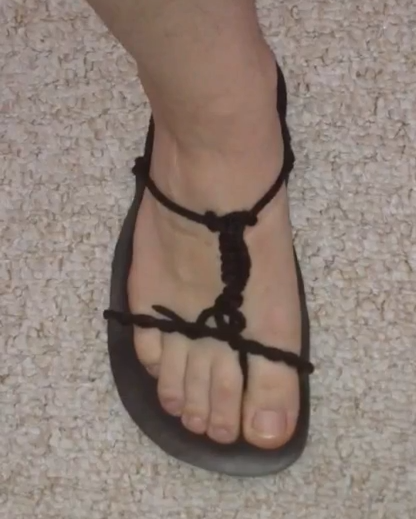
Lee Chase's "Extra Comfy" Huarache Tying Style
Lee Chase developed this variation of one of the tying styles on the Tying page. The only thing I'd do differently: Take the end of the lace and put it back through the half hitches to lock it in place. First, a few tying tips and notes: Tying the Lace knot: This is the knot we most commonly use, especially with our 100% polyester laces. The "Lace Bead": This is the smallest "knot" you can make for your Xero Shoes. Tying a Figure-8 knot: If you have our original laces with the nylon core, you'll want to use this knot. Lacing tips: Lee's "Extra Comfy" style Step-by-Step instructions coming soon!
Barefoot running efficiency
Is barefoot running more or less efficient than running in shoes?Who cares?! Barefoot is fun! And we think barefoot is good for you, too.Besides, the recent studies that say barefoot is less efficient are riddled with holes (including that one only showed that "barefoot-style" running was less efficient for people who had no experience with it!Anyway, I think this equation sums up the benefits of being barefoot or in Xero Shoes ;-).And since it's math, you know it must be true!
Minimalist sandals are our life!
When Lena and I started Xero Shoes in November 2009, we thought, "Oh, this'll be a nice little hobby business." We never anticipated it growing as much as it has, or working as hard as we work ;-)After appearing on Shark Tank last night, we've been SWAMPED with orders, emails, phone calls.I've been awake and on my feet (I have a treadmill desk) for about 40 hours (don't even ask me about the list of technical problems we ran into). Lena's working on 1/2 the sleep she normally gets. And everyone else in the office -- Bill, Kim, and Rudy (Dennis is in Asia working on some very exciting new products) -- put in a great effort today.Here's what 500 orders looks like (and we've got another 200 left to go!). Our mailman is going to hate us on Monday.In the middle of my brain-deadness, I want to say how grateful we are to share Xero Shoes and the idea of natural movement with everyone. Getting dozens of emails every day from people who are doing everything from taking a stroll to running an ultramarathon... well, it makes these long days worthwhile. So, THANKS!
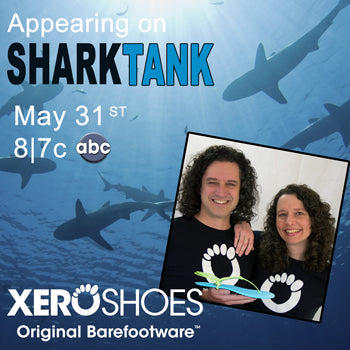
Xero Shoes on Shark Tank... AGAIN!
We just got the word from ABC and Mark Burnett Productions that our Shark Tank episode is re-airing on Friday, May 31st.Frankly, we're still reeling from the effects of our original air date in February. We sold over 3,000 pairs of Xero Shoes barefoot sandals after the show aired... and that was in the middle of WINTER!Lena and I are tremendously grateful for all the things that have happened as a result of being on the show (if you haven't seen it yet, I won't spoil the surprise of what happened). Thanks to getting recognized (at events where there are a lot of entrepreneurs, we're like rock stars :-P ), and thanks to the exposure, we've met dozens of people who are helping us improve our products, our marketing, our business... everything but our ability to take a day off.So there are a lot of changes coming up. You'll see the look and feel of the website changing, some new ways to discover and share lacing and tying styles, contests that you can enter (What can YOU do with Xeros?), and some new products that are on the way.We can't wait to see what the next few months bring. We're always excited to see how barefoot living (which is more than just running barefoot) spreads, how one family member gets a pair of Xero Shoes and then everyone else in the family orders a pair a week later.And we're thrilled that we've been able to provide more support to the Tarahumara Children's Hospital Fund than we ever thought we could.Watch us on Friday, and join in on Twitter and Facebook and Instagram. Tell everyone what you like about your Xero Shoes! On Twitter, use #sharktank and @xeroshoes.

A lacing tip for your Xero Shoes
Here's a fun lacing tip/trick you can use with your Xero Shoes.Basically, it's making a "lacing loop" out of a small section of our new laces or using our toe loops.There are two reasons you may want to do this:1) It's a cool decorative element (especially if you use a different color for the loop than you do for the rest of your lacing), and lets you re-lace your Xero Shoes really fast.Here's what our sales manager, Rudy, did with this idea, when he added a loop at the ankle holes and toe hole:2) The other thing this lacing loop is good for is "addressing" a form problem.A very small number of people will create abrasion at the outside ankle hole which wears out the lace at that spot (FWIW, I and all the Xero wearers I know have put tens of thousands of miles on their shoes without ever wearing out a lace).If you do this, you can "fix" the problem, by attending to your gait (and stopping creating the extra horizontal friction that causes the problem).OR... you can "address" the problem by making the lace more resistant to abrasion. One way to do that is by rubbing some Shoe Goo on the lace. The lacing loop is another.The video below explains how to make the lacing loop and why you would use it.I can't wait to see what you do with this idea!
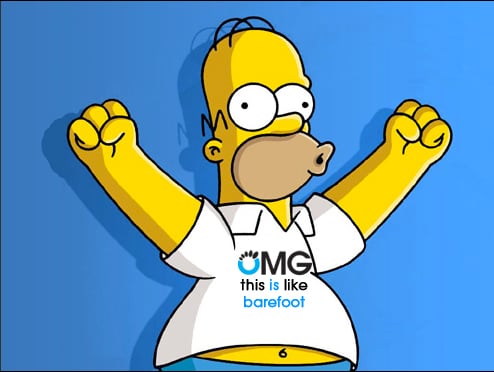
Woo-Hoo. Homer loves his Xero Shoes!
Woo-Hoo!Homer loves his Xero Shoes, too!;-)
The dumbest barefoot running study yet?
National Taiwan Normal University recently published a study in the journal, Gait & Posture, that might be the dumbest study ever done about barefoot running.Or, now that I think of it, it maybe it's the best.Hmmm...Let's start with the study and then I'll tell you why it's so stupid and so awesome at the same time.I don't need to bother with how the study was conducted and the typical problems with the study design, which are common to most of the barefoot running studies that have been done (too small a sample size, too homogeneous a sample size, not a good control group, lack of barefoot experience when barefoot experience is called for, etc. -- oh, I guess I did just bother :lol:).The important part is the conclusion:Habitually shod runners may be subject to injury more easily when they run barefoot and continue to use their heel strike pattern.Winner of the DUH! AwardFor those of you with some barefoot running experience under your belt, you'll immediately get the "this is a stupid study" idea.For those of you new to the barefoot thing, let me 'splain. In short, the one of the key philosophies behind running without shoes is that the typical heel-striking pattern that most people adopt when they put on running shoes, regardless of how much padding and motion stability is built into the shoes, is BAD FOR YOU.Adding the padding and motion control is attempting to address a problem that the shoe caused to begin with. It's like drilling a hole in a water pipe and then trying to patch it up with Silly Putty and saying, "See, it's fine!"Another philosophy of barefoot running is that it'll get you to stop heel-striking because, news flash, landing on your heel while barefoot HURTS.So, doing a study that says, "Running barefoot and heel-striking can be bad for you" is like doing a study that reveals, "Water is wet!"There isn't a barefoot runner on the planet who is surprised by these results.Winner of the AAAAWWWWESOOOOMMMMME AwardIronically, though, the obviousness of this study -- problems and all -- is what makes it one of the best studies about barefoot running yet.Why?Because it proves one of the core tenets of barefoot running!Okay, again, it doesn't unambiguously and completely prove it because of the limitations of the study. But by examining one of the simple ideas behind the barefoot movement and determining that all our anecdotal evidence has some scientific background, we can start to chip away at the nay-sayers who intone, "There are no studies that show that running barefoot is better for you."Ignoring the argument that there are no studies that show that SHOES are good for you, we now have a small study that backs up our claims.Winner of the That's What She Said! AwardOne other conclusion that came out of this study is that, perhaps, the advantages that barefoot running seems to provide come not from having your bare skin on the ground, but from the change in gait -- from heel-strike to, well, NOT heel-striking -- is where the real value comes from.That's the message that many of us -- including Chris McDougall, Daniel Lieberman, and Pete Larson -- have been saying. That is, "it's the form, not the footwear... but it happens that removing the footwear seems the best way to change the form... and it's FUN, feels great, and costs less."Hopefully we'll start seeing other studies that address some of the other simple claims of barefooters: Running barefoot naturally leads to a change in gait, without supplemental instruction That gait change, even in shoes, leads to fewer injuries That gait change, without shoes, leads to fewer injuries That gait change helps heal existing injuries ANYONE can run barefoot, pain-free and enjoyably. (Did I miss any?)
Barefoot Running Expert Daniel Lieberman on The Colbert Report
Most barefoot runners know Daniel Lieberman from Chris McDougall's best-seller, Born To Run.Dr. Lieberman is a professor of Evolutionary Biology at Harvard who has done some seminal research on barefoot running. One of his basic premises, from an evolutionary perspective, is that human's ability to sweat allowed us to run for long distances, letting us track down prey that overheats and tires out.While Dr. Lieberman is used to big deal academic situations, here he is on The Colbert Report.
Who wears running shoes... really?
It's no surprise that the vast majority of the people wearing Air Jordan's don't play basketball, that almost nobody who wears the Puma Faas shoes will give Usain Bolt a run for his money.Well, Saturday Night Live nailed it with this commercial for New Balance ;-)Like it? Then SHARE IT.



